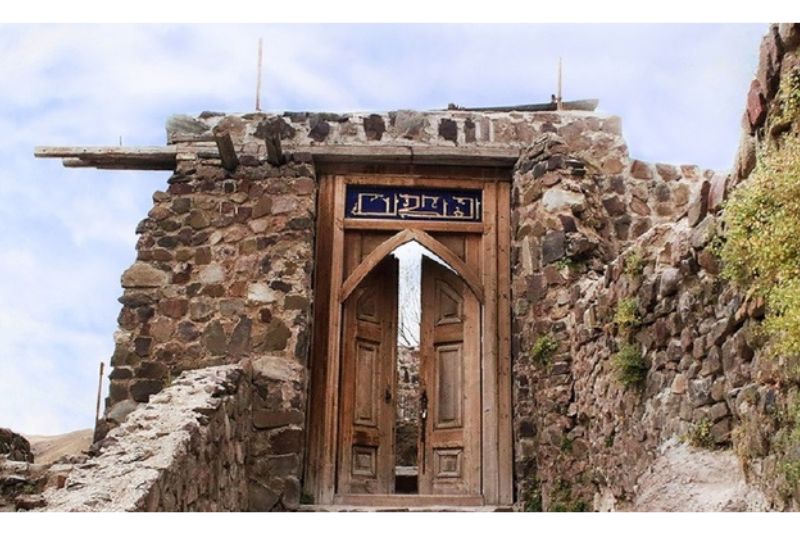Alamut Castle | Mythic Mountain Stronghold
High in the mountains of Iran, you'll find Alamut Castle, a fascinating place with ancient stories to tell.
This old fortress, perched on a cliff, is like a time machine that takes you back in time. It's full of secrets and history, making it a great place to explore. If you're curious and love adventure, Alamut Castle is the perfect destination for you. It's a window to a world of mystery and excitement from the past.
History of Alamut Castle
Alamut Castle was founded and constructed by Hasan-i Sabbah, a charismatic leader and the founder of the Nizari Ismaili sect (minority sect within Islam), also known as the Assassins. Hasan-i Sabbah was born in the city of Qom, Persia (modern-day Iran), in 1050.
Hasan-i Sabbah was a prominent figure within the Ismaili sect and was inspired by the idea of creating an independent state under Ismaili leadership. He chose the remote region of Alamut in the Alborz Mountains for this purpose due to its strategic value.
The construction of Alamut Castle is believed to have begun around 1090 AD. It took several years to complete this formidable fortress, which was built on a high and almost inaccessible rock formation.

Early Years and Significance
- In its early years, Alamut Castle served as the headquarters for the Nizari Ismaili sect, and it played a pivotal role in the Ismaili community's religious and political activities.
- The castle's location, high in the Alborz Mountains, made it nearly impervious to conventional military assaults, contributing to its significance as a powerful fortress.
- Hasan-i Sabbah envisioned Alamut Castle as a center for both religious and military training. It was here that he indoctrinated his followers, the Assassins, into his unique beliefs and established a hierarchy of devoted individuals.
- The fortress was also used to exert control over a region that included important trade routes and settlements, further enhancing its strategic importance.
- Alamut Castle was not only a symbol of military strength but also a center for intellectual and cultural pursuits. It housed a library and scholars, contributing to the development of the Nizari Ismaili community.
- The castle's symbolic and strategic importance attracted the attention of various regional powers and invaders, leading to a series of historical events and conflicts that have left an indelible mark on the castle's history.
| Related: Top 9 Most Beautiful and Historical Castles in Iran
Mongol Invasions
One of the most notable invasions in the history of Alamut Castle was carried out by the Mongols. In the early 13th century, under the leadership of Hulagu Khan, the grandson of Genghis Khan, the Mongols launched a series of campaigns against various strongholds in Persia.
There is a belief that the Assassins made an attempt on Möngke Khan's life. In response, the Mongols mobilized their armies to attack the various Hashishin strongholds, eventually achieving victory at Alamut in 1256. Although they later reclaimed Alamut, they lost it again.
| Read more: Iran's History
Afghan Invasions
In the 18th century, Alamut Castle witnessed another invasion, this time by Afghan forces. The Afghan invasions in Iran during this period had far-reaching consequences for various regions, and Alamut was no exception.
The Afghan invasion resulted in further damage to the castle, and it remained under Afghan control for a significant period.
| Related: Nader Shah Afshar - The Conqueror of Empires
The Origin of the Name "Alamut"

The name "Alamut" has its roots in Persian. "Alam" means "eagle" in Persian, and "ut" is a suffix denoting a place. Therefore, "Alamut" roughly translates to "Eagle's Nest" or "Eagle's Lair." This name aptly describes the high, almost inaccessible location of the castle, perched on a rocky outcrop in the Alborz Mountains.
| Discover: Top 10 Historical Sites of Iran - Add these to your to-visit list.
Who were the Assassins of Alamut Castle?
The term "Assassin" is originated from the Arabic "Hashishin," but the name "Hashishin" likely stems from a story, potentially fabricated by their enemies, explaining how their leader, Hasan, gained loyal followers.
According to this tale, Hasan would kidnap men and bring them to his stronghold, where they were drugged with hashish and put into a trance. In this altered state, they were promised sensual pleasures and made to believe they were in paradise. Once they came out of this state, they were sent on dangerous missions. They were assured that if things went wrong, they would return to paradise, making them fearless.
The term "Hashishin" was derogatory, possibly meant to label them as "rabble" or "outcasts."

Sabah's secret society had five levels: Grand Headmaster (originally Sabah), Greater Propagandists, Propagandists, Rafiqs, and Lasiqs. The Lasiqs, the lowest rank, were trained as assassins. They were not mindless killers but highly skilled individuals proficient in combat, disguise, and well-educated to blend in with different societies.
Their core belief was that eliminating a few key figures was preferable to large-scale wars that caused numerous casualties. Sabah, while enigmatic in his intentions, employed his assassins to eliminate various leaders and also took money for contract killings if it aligned with their overall plan.
Despite their ruthless reputation, the Hashishin were careful not to harm anyone except their intended targets, especially avoiding harm to commoners and innocent bystanders.
| Discover: Taq Bostan - Sassanid Rock Reliefs in Kermanshah, Iran
The Architecture: How high is Alamut Castle?
Alamut Castle exhibits a unique and strategic architectural design. It is perched atop an almost insurmountable rocky elevation, standing proudly at an elevation of 2163 meters above sea level, towering 200 meters higher than the surrounding terrain. The castle's triangular shape, with its base along the mountain's edge, leveraged its natural defenses, while precipices and steep slopes on all four sides made it an imposing and challenging fortress to access.

Size and Dimensions
The exact dimensions of Alamut Castle can vary by source, but it covers a significant area atop the promontory. The sprawling castle complex includes various structures and defensive features designed to secure the site against attackers. While much of the castle's tower and fortifications have succumbed to the passage of time, today, only three towers remain: one in the north, one in the south, and the eastern tower, which has endured better than the others. Access to the castle is feasible solely through a single entrance positioned at the extreme northeastern edge and located a few meters below the east tower, as no other entry point exists, underscoring the castle's remarkable security and isolation.
| Discover: Iranian Traditional Architecture
Defensive Features
Alamut Castle's defensive features were crucial to its reputation as an impregnable fortress. Some of the notable defensive elements include:
- Multiple concentric walls and gates, making it difficult for attackers to breach the inner sanctum.
- Cleverly designed escape routes and hidden passageways to confound invaders.
- A sophisticated system of tunnels and chambers within the rock itself, providing both shelter and means of escape.
- Bastions, arrow slits, and fortifications designed to protect the inhabitants from attacks.
- The natural terrain, including steep cliffs and rugged mountainsides, acted as a formidable natural defense.
Eastern Part
The Eastern Part of Alamut Castle, known as Pilaqala or The Lower Castle, was situated on the lower levels of the promontory. It contained residential quarters, storage areas, and facilities for the inhabitants.
Western Part
The Western Part, known as Jorqala or The Upper Castle, occupied the higher reaches of the promontory. It was where the most critical and strategic functions of the castle were located, including command and control centers.

Hand-Dug Section
Within the rock itself, the inhabitants of Alamut Castle dug a network of tunnels and chambers, providing secret routes and storage space. This hand-dug section also served as a refuge during sieges.
Mowla Sara
Mowla Sara was a particular area within the castle complex, possibly used for religious or ceremonial purposes. It may have had a religious significance to the Nizari Ismaili community.
Notable Architectural Features
Alamut Castle featured a range of architectural marvels, such as:
- Underground chambers and tunnels carved into the rock, showcasing the innovation of its builders.
- Ingeniously designed hidden escape routes.
- A sophisticated water supply system, including a reservoir, to ensure the fortress had access to fresh water during times of siege.
- Defensive elements like arrow slits and fortified walls, highlighting the careful thought put into its defensive capabilities.
| Read more: Iranian Modern Architecture
How to Get to the Alamut Castle?

To get to Alamut Castle, you'll need to travel to the Alamut region in Iran. The castle is situated in a remote, mountainous area, so reaching it can be an adventure in itself. Here are the general steps to reach Alamut Castle:
- Travel to Qazvin: Start by getting to the city of Qazvin, which is the nearest major city to Alamut. You can reach Qazvin by car, bus, or train from Tehran, Iran's capital. Qazvin is approximately a 2 to 3-hour drive from Tehran.
- Find Local Transportation: From Qazvin, you'll need to arrange local transportation to the village of Gazorkhan. This typically involves hiring a taxi or a local driver who knows the area well. The village of Gazorkhan is often considered the gateway to Alamut Castle.
- Hike or Ride a Horse: From Gazorkhan, you can choose to either hike or ride a horse to reach the castle. The hike is approximately 2-3 hours and involves a steep climb. Horseback riding is a popular and relatively easier option, especially for those not accustomed to strenuous hiking.
- Follow a Guide: It's highly recommended to hire a local guide who knows the trails and can lead you to Alamut Castle safely. The terrain can be challenging, and a guide can ensure you take the best route.
- Check for Local Restrictions: At times, there may be restrictions or closures due to weather or other factors. It's a good idea to check with local authorities or a travel agency in Qazvin before planning your visit.
Must-Sees Around Alamut Castle
The region surrounding Alamut Castle is renowned for its breathtaking natural beauty. Some of the natural attractions include:
- Alamut Valley: The valley surrounding the castle is lush and dotted with villages, making it a picturesque location for hiking and exploration.
- Waterfalls: There are several enchanting waterfalls in the area, such as the Roodafshan Waterfall, which provide tranquil spots for relaxation and photography.
- Flora and Fauna: The region boasts diverse flora and fauna, and nature enthusiasts can observe various plant and animal species.

The vicinity of Alamut Castle is rich in historical sites that offer further insights into the region's history and culture:
- Lambesar Castle: Located not far from Alamut, Lambesar Castle is another historical fortress worth visiting. It shares a similar history with Alamut in terms of its use by the Nizari Ismailis.
- Nizari Ismaili Sites: Explore the remnants of other Nizari Ismaili strongholds and historical sites in the region, which collectively provide a broader perspective on their activities and influence.
- Historic Villages: Visit traditional villages in the Alamut Valley, such as Gazorkhan, and engage with local communities to learn about their customs and heritage.
| Suggestion: Ghoortan Citadel - Desert Fortress of Legends
Accommodations Nearby
While the Alamut region is known for its remote and rugged landscape, there are limited accommodation options available in the vicinity of Alamut Castle. Most visitors prefer to stay in nearby citie, towns or villages such as Tehran, Karaj, Qazvin, Gazorkhan, Alamut Valley and Lavasanat. They offer a wider range of accommodation options, including hotels, hostels, and guesthouses.
Best Time to Visit Alamut Castle

The best time to visit Alamut Castle in Iran is during late spring (April to June) and early autumn (September to October) when the weather is mild, and the natural surroundings are at their most picturesque. Summer (July and August) can be hot, so be prepared. It's not recommended to visit during late autumn to winter (November to March) due to cold weather and possible snowfall, which can make access challenging. Always check local weather conditions before planning your trip.

Bottom Line
We encourage you to plan your trip, discover the secrets of this remarkable fortress, and savor the unique charm of the Alamut region.
Whether you're captivated by its historical significance, intrigued by its architectural marvels, or simply seeking an adventure in the mountains, Alamut Castle promises an unforgettable experience.
Share your story!
Comment below and let us know about your Experience.
Your story inspires others!


Comment
Leave a Comment